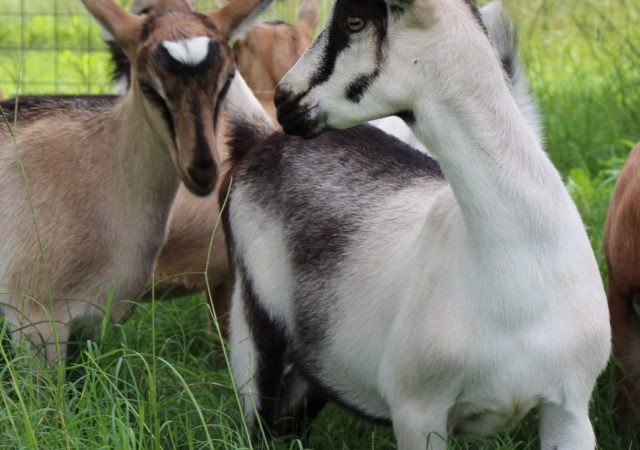

When raising dairy goats, the first step is breeding the doe. You may then wonder, “How long is goat gestation?” Taking a look through the entire process will set you up for a more successful start.Deciding whether to breed the doe should include several factors. For first time breeders, look at physical maturity of the doe. Has she finished most of her growth? Are the teats well formed? Look at udder conformation.
Most breeds reach sexual maturity by five to six months of age, but you may want to wait until eight to twelve months before breeding. If your doe is on the smaller side of breed size, choose a buck that is also smaller. Otherwise, she may have trouble delivering large kids.If you are repeat-breeding the doe, look at your goat’s gestation history, since this can help you avoid problems after breeding. Does that had issues in the past may not have them with subsequent kiddings, but be prepared to assist with problems such as delivery emergencies, rejected kids, milk fever and low milk production.
Before breeding, some goat owners will flush her, to bring up pre-pregnancy weight. Flushing is done by adding extra grain or higher-quality forage to the doe’s diet and can cause her to release more eggs during estrus, thereby increasing the chances of a successful breeding.
Seasonal Breeders
Most goat breeds, including most dairy breeds, are seasonal breeders, meaning they come into a season of estrus for a few months out of the year. This includes Pygoras, a fiber-producing breed. Nigerian Dwarf, Boers, Spanish, fainting goats, and pygmy goats are year-round breeders. When breeding the doe, look for estrus. Tail-wagging, bleating, and a mucus discharge from the vulva are some common signs of goat reproduction. She will have an estrus cycle approximately every 20 days.
During the two or three days that she is in heat, the ovaries release eggs. If breeding occurs during this time, the doe will likely end up pregnant.In most breeds, fertility cycles occur late summer into late fall or early winter. Commonly, does will be in estrus or heat during August, September and October. If you have a buck in with the does, he will also alert you to a doe in heat. Bucks have distinct behavior during breeding season, including tongue flapping and a distinctly unpleasant smell from the urine. Be cautious when thinking about running a buck with the herd. If he has access to the does all the time, it is harder to estimate when the kidding will take place.
While many does can and do give birth unassisted, even in the field, occasionally assistance or emergency methods are needed. Knowing approximately when your does will kid gives you a chance to be on hand to assist.Keep in mind that even older does, that should not be bred any longer, will still cycle and have a heat. They often have more problems with goat gestation. If you do not want to put an older female at risk of a problem goat pregnancy, make sure she has no contact with a buck during breeding season.Goat gestation is approximately 150 days. Of course, this will vary based on individuals and breeds. Knowing how long a doe is pregnant is key to scheduling your kidding season. Breed the doe to kid at a convenient time by counting back from the desired time frame.
What to Do While Your Doe is Expecting
For most of the goat’s gestation period, you won’t need to change her routine. If the doe is in good condition before breeding, she will be able to breeze through the pregnancy. Add additional care during the last few days.At 100 days, increase the feed according to the recommendations from the feed company.
Trimming hair from the udder and crotch area may be needed, depending on the goat. In selenium-deficient areas, give selenium injections one month before the due date. If you are unsure if your area’s soil is deficient in selenium, ask your livestock vet or a county ag-extension agent. In addition, many goat breeders will give a vitamin booster of A, D and E around day 135.As kidding time approaches, prepare smaller birthing areas in your barn. A larger stall can be sectioned off into a few kidding pens so the doe can labor and deliver in a quiet environment. Line the floor with deep straw and prepare your emergency goat delivery supplies, keeping these supplies close at hand. Few goats will wait to go into labor while you run back to the house to collect supplies. And while I believe that most goats don’t need us in order to deliver healthy kids, you will be so glad you prepared for emergencies if problems happen.
When Labor Begins
Goat labour signs are individual. Some does will want to wander away from the flock. Vocalizing is common; some does become quite loud. The udder fills, although this can also happen right before kids appear! The ligaments around the tail relax and become mushy. The doe may bite at her sides and make soft sounds to her baby. She may seek you out or totally try to get away from you. It’s different with each doe.
 Contact Jaguza Support
Contact Jaguza Support